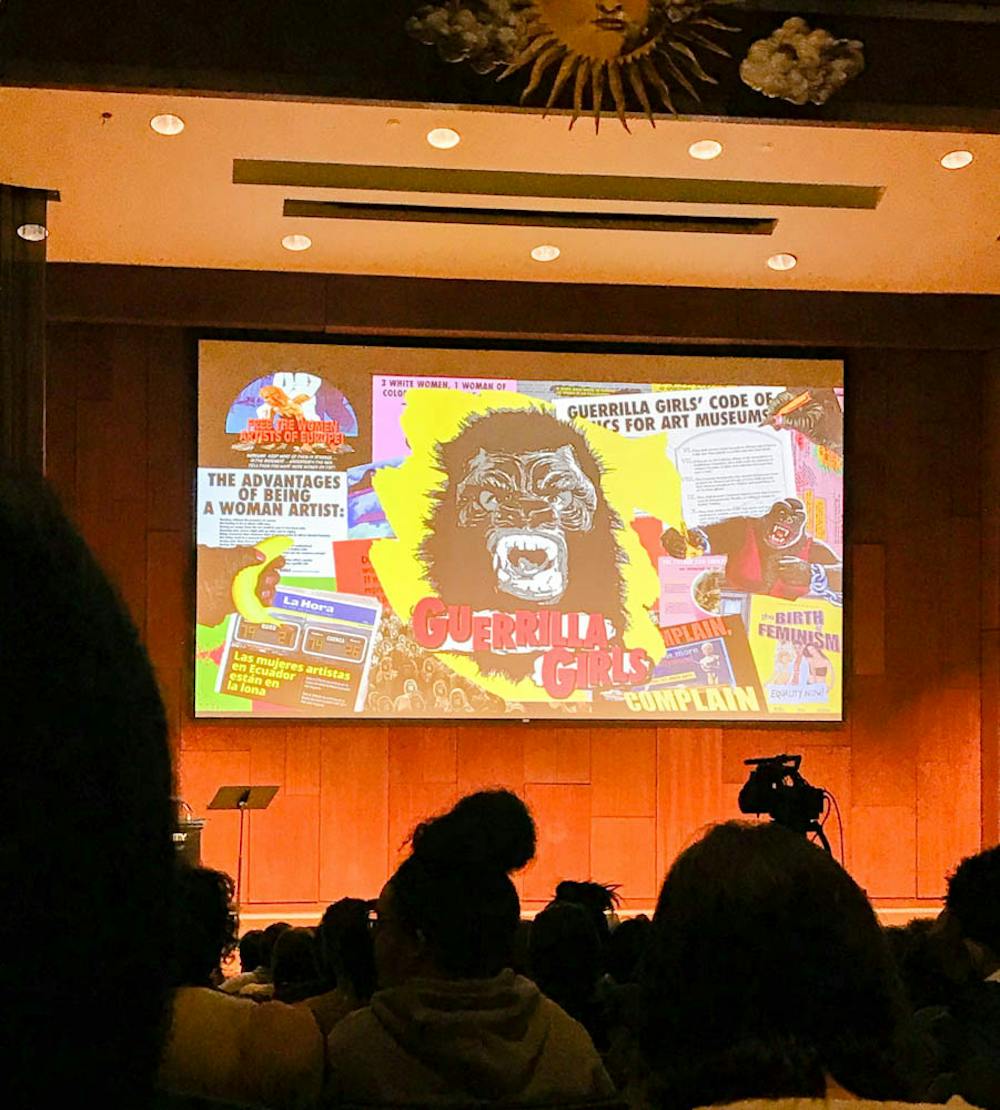A Guerrilla Girl, known by her pseudonym “Frida Kahlo,” strolled through the aisles of the Salomon Hall auditorium while handing out bananas to various audience members Wednesday. The anonymous artist, who uses the famous Mexican artist’s name as a pseudonym, wore the Guerrilla Girls’ iconic gorilla mask, drawing laughter and applause from the large crowd.
Known for masking their identities to focus on their work and activism, the Guerrilla Girls combat discrimination and inequality in the artistic and political worlds through their posters, books and other protest art. At the artist talk presented by the University’s Department of Visual Art, Frida Kahlo discussed the group’s history and quest to expose inequality, all the while donning their infamous gorilla masks.
She prefaced the talk by acknowledging the University’s history of occupying indigenous land and involvement with slavery. “In order to understand the time that we live in,” Kahlo said, “we must honor and respect those who have endured and continue to endure the horrors of this history.”
Kahlo then began her presentation with a quote by the Greek philosopher Pythagoras. “There is a good principle, that created order, light and men,” she voiced dramatically. “And an evil principle, that created chaos, darkness and women.” The audience laughed as she continued to rattle off quotes that expressed the horrors of women, from ancient to modern men of the humanities, science and art worlds. Kahlo ended the list of quotes by asking the audience to collectively scream — the crowd promptly did so.
A founding member of the Guerrilla Girls, Kahlo recounted her involvement with the group’s activism since 1985. She traced the intersectional feminist group’s history from its beginning attempts to expose the art world’s bias toward white male artists. One of their first protests involved wheatpasting a series of posters that asked, “How many women had one-person exhibitions at NYC museums last year?” The answer read, “Guggenheim - 0, Metropolitan - 0, Modern - 1, Whitney - 0.”
Kahlo described the process behind the group’s first iconic posters. “We just took the streets; we didn’t ask anyone’s permission,” she stated. “But we wanted to do posters that revealed the truth about discrimination in New York City. … We were just pissed off, and we were surprised that the posters took everyone’s attention … and started public dialogue.”
With a huge public response, from interviews with art magazines to commissions with various social organizations, the Guerrilla Girls continued to highlight sexism and racism, as well as tokenism, in the art scene. A common practice that they used was their “weenie counts,” in which the group compared the number of male and female nude figures in the Metropolitan Museum. They found that over 85 percent of the nudes were female even though less than five percent of the artists were women, and even fewer of those artists were women of color.
“Now, we hope you don’t get the idea that we don’t love art. We love art and artists — but let’s face it — the art world kind of sucks,” Kahlo said, addressing the glaring gender, economic and racial inequalities within museums and the art market.
Kahlo also discussed the Guerrilla Girls’ other work, including street art, billboards and stickers, in cities such as Bilbao, Madrid, Shanghai and more. More recently, the group has spread awareness regarding the dominance of white males in Hollywood with large-scale billboards. They have also created art in support of reproductive rights in movements such as the Women’s March and criticized corruption within the American government and presidency.
She ended the talk with a video featuring a soundtrack by feminist music and art ensemble “Chicks on Speed.” The video encouraged viewers to join “a world of artistic cooperation and collaboration” and communicated the Guerrilla Girls’ mission of revealing marginalized narratives in pop culture and art. In the video, various Guerrilla Girls members called upon the audience to “be crazy” and “change people’s minds, and do it in an unforgettable way.”
Audience member Zachary Mothner ’22 found the Guerrilla Girls’ presentation to be both stimulating and informative. “I found it really compelling how the Guerrilla Girls have sparked so much dialogue in both the artistic and political worlds through their art,” he said. “It is really inspiring to see how they call attention to racial and gender biases in the still-problematic art world and community.”





